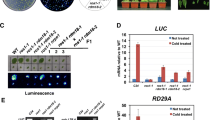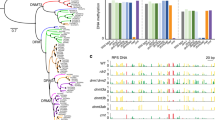Abstract
In vertebrate genomes the dinucleotide CpG is heavily methylated, except in CpG islands, which are normally unmethylated. It is not clear why the CpG islands are such poor substrates for DNA methyltransferase. Plant genomes display methylation, but otherwise the genomes of plants and animals represent two very divergent evolutionary lines. To gain a further understanding of the resistance of CpG islands to methylation, we introduced a human CpG island from the proteasome-like subunit I gene into the genome of the plant Arabidopsis thaliana. Our results show that prevention of methylation is an intrinsic property of CpG islands, recognized even if a human CpG island is transferred to a plant genome. Two different parts of the human CpG island – the promoter region/ first exon and exon2–4 – both displayed resistance against methylation, but the promoter/ exon1 construct seemed to be most resistant. In contrast, certain sites in a plant CpG-rich region used as a control transgene were always methylated. The frequency of silencing of the adjacent nptII (KmR) gene in the human CpG constructs was lower than observed for the plant CpG-rich region. These results have implications for understanding DNA methylation, and for construction of vectors that will reduce transgene silencing.
Similar content being viewed by others
References
Antequera F and Bird A (1993) CpG islands. In: Jost JP and Saluz HP (eds) DNA Methylation: Molecular Biology and Biological Significance. Birkhauser Verlag, Basel.
Antequera F and Bird A (1999) CpG islands as genomic footprints of promoters that are associated with replication origins. Curr Biol 9: R661–R667.
Assaad FF, Tucker KL and Signer ER (1993) Epigenetic repeat-induced gene silencing (RIGS) in Arabidopsis. Plant Mol Biol 22: 1067–1085.
Barakat A, Gallois P, Raynal M, Mestre-Ortega D, Sallaud C, Guiderdoni E, Delseny M and Bernardi G (2000) The distribution of T-DNA in the genomes of transgenic Arabidopsis and rice. FEBS Lett 471: 161–164.
Barakat A, Matassi G and Bernardi G (1998) Distribution of genes in the genome of Arabidopsis thaliana and its implications for the genome organization of plants. Proc Natl Acad Sci USA 95: 10044–10049.
Bestor TH, Gundersen G, Kolstø A-B and Prydz H (1992) CpG islands in mammalian gene promoters are inherently resistant to de novo methylation. Genet Anal Tech Appl 9: 48–53.
Bird AP (1986) CpG-rich islands and the function of DNA methylation. Nature 321: 209–213.
Bird AP (1992) The essentials of DNA methylation. Cell 70: 5–8.
Bolden AH, Ward CA, Nalin CM and Weissbach A (1986) The primary DNA sequence determines in vitro methylation by mam-malian DNA methyltransferases. Prog Nucleic Acid Res Mol Biol 33: 231–250.
Brandeis M, Frank D, Keshet I, Siegfried Z, Mendelsohn M, Nemes A, Temper V, Razin A and Cedar H (1994) Sp1 elements protect a CpG island from de novo methylation. Nature 371: 435–438.
Carotti D, Palitti F, Lavia P and Strom R (1989) In vitro methylation of CpG-rich islands. Nucleic Acids Res 17: 9219–9229.
Devereux J, Haeberli P and Smithies O (1984) A comprehensive set of sequence analysis programs for the VAX. Nucleic Acids Res 12: 387–395.
Elomaa P, Helariutta Y, Griesbach RJ, Kotilainen M, Seppanen P and Teeri TH (1995) Transgene inactivation in Petunia hybrida is influenced by the properties of the foreign gene. Mol Gen Genet 248: 649–656.
Feinberg AP (1993) Genomic imprinting and gene activation in cancer. Nature Genet 4: 110–113.
Gardiner-Garden M and Frommer M (1987) CpG islands in vertebrate genomes. J Mol Biol 196: 261–282.
Gardiner-Garden M and Frommer M (1992) Significant CpG-rich regions in angiosperm genes. J Mol Evol 34: 231–245.
Gundersen G, Kolstø AB, Larsen F and Prydz H (1992) Tissue-specific methylation of a CpG island in transgenic mice. Gene 113: 207–214.
Klemsdal SS, Hughes W, Lønneborg A, Aalen RB and Olsen OA (1991) Primary structure of a novel barley gene differentially expressed in immature aleurone layers. Mol Gen Genet 228: 9–16.
Koncz C and Schell J (1986) The promoter of TL-DNA gene 5 controls the tissue-specific expression of chimaeric genes carried by a novel type of Agrobacterium binary vector. Mol Gen Genet 204: 383–396.
Kooter JM, Matzke MA and Meyer P (1999) Listening to the silent genes: transgene silencing, gene regulation and pathogen control. Trends Plant Sci 4: 340–347.
Larsen F, Gundersen G, Lopez R and Prydz H (1992) CpG islands as gene markers in the human genome. Genomics 13: 1095–1107.
Larsen F, Solheim J, Kristensen T, Kolstø AB and Prydz H (1993) A tight cluster of five unrelated human genes on chromosome 16q22.1. Hum Mol Genet 2: 1589–1595.
Leutwiler L, Hough-Evans B and Meyerowitz E (1984) The DNA of Arabidopsis thaliana. Mol Gen Genet 194: 15–23.
Macleod D, Charlton J, Mullins J and Bird AP (1994) Sp1 sites in the mouse aprt gene promoter are required to prevent methylation of the CpG island. Genes Dev 8: 2282–2292.
Mandal A, Lång V, Orczyk W and Palva ET (1993) Improved efficiency for the T-DNA-mediated transformation and plasmid rescue in Arabidopsis thaliana. Theor Appl Genet 86: 621–628.
Mehtali M, LeMeur M and Lathe R (1990) The methylation-free status of a housekeeping transgene is lost at high copy number. Gene 91: 179–184.
Meyer P and Heidmann I (1994) Epigenetic variants of a transgenic petunia line show hypermethylation in trans-gene DNA: an indication for specific recognition of foreign DNA in transgenic plants. Mol Gen Genet 243: 390–399.
Morel J-B, Mourrain P, Béclin C and Vaucheret H (2000) DNA methylation and chromatin structure affect transcriptional and post-transcriptional transgene silencing in Arabidopsis. Curr Biol 10: 1591–1594.
Murashige T and Skoog F (1962) A revised medium for rapid growth and bioassays with tobacco tissue cultures. Physiol Plant 15: 473–497.
Pröls F and Meyer P (1992) The methylation patterns of chromosomal integration regions influence gene activity of transferred DNA in Petunia hybrida. Plant J 2: 465–475.
Riggs AD and Pfeifer GP (1992) X-chromosome inactivation and cell memory. Trends Genet 8: 169–174.
Steinum TM, Berner HS, Stacy RAP, Salehian Z and Aalen RB (1998) Differential regulation of the barley (Hordeum vulgare) transcripts B22E and B12D in mature aleurone layers. Physiol Plant 102: 337–345.
Tweedie S and Bird A (2000) Gene expression. Mutant weed breaks silence. Nature 405: 137–138.
Author information
Authors and Affiliations
Corresponding author
Rights and permissions
About this article
Cite this article
Meza, T.J., Enerly, E., Børud, B. et al. A Human CpG Island Randomly Inserted Into a Plant Genome is Protected From Methylation. Transgenic Res 11, 133–142 (2002). https://doi.org/10.1023/A:1015244400941
Issue Date:
DOI: https://doi.org/10.1023/A:1015244400941




